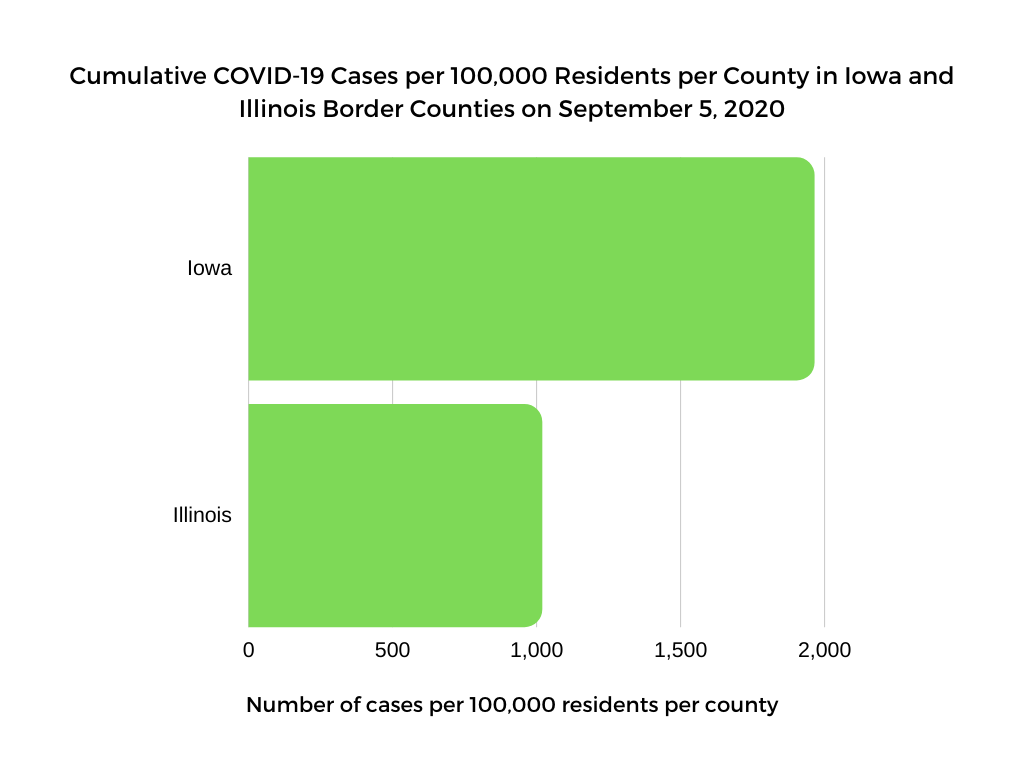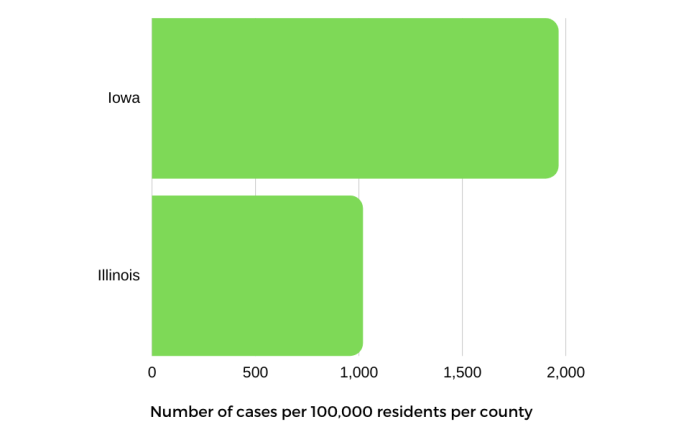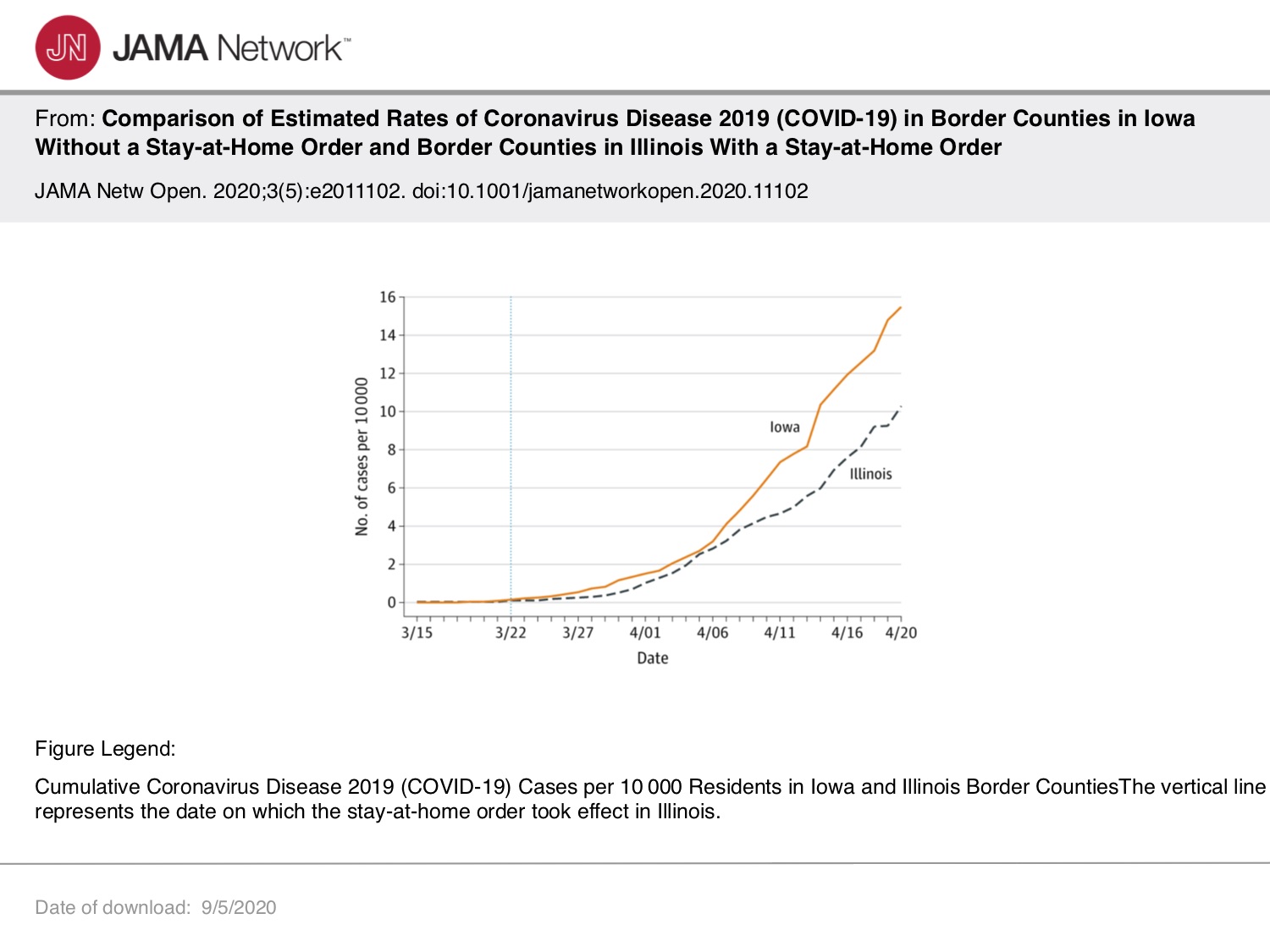Preethi Reddi found that eight Iowa counties along the Mississippi River continue to have more COVID-19 cases per capita than seven border counties on the Illinois side. -promoted by Laura Belin
In May, Governor Kim Reynolds and the four other Republican governors who elected against stay-at-home orders prematurely published an editorial in the Washington Post titled, “Our states stayed open in the covid-19 pandemic. Here’s why our approach worked.”
Recent data contradict that bold title and point to a need for change in Reynolds’s less aggressive approach to controlling COVID-19 spread.
In the past two weeks, Iowa cities have led in number of new COVID-19 cases, but Reynolds continues to dismiss the White House coronavirus task force’s recommendations for a mask mandate, bar closures in 61 of 99 Iowa counties, and limits on the size of social gatherings.
Iowa leaders must acknowledge data suggesting pitfalls in their policies and messaging. They should work towards a new approach that better protects the health and safety of their constituents.
A study published in the Journal of the American Medical Association (JAMA) in May compared COVID-19 rates in eight Iowa counties and seven Illinois counties along the Mississippi River. At the start of the study, COVID-19 rates were similar across the Iowa and Illinois border counties. However, results showed that COVID-19 cases increased more rapidly on the Iowa side of the river, compared to Illinois counties following that state’s enactment of a stay-at-home order.
The same results were found when researchers controlled for population density, poverty status, and the timing of school and nonessential business closures in both states. These results are consistent with another study that showed an association between reduced COVID-19 cases and a statewide stay-at-home order in California.
Using the New York Times Coronavirus Tracker for the Iowa and Illinois border counties examined in the JAMA study, I calculated cumulative COVID-19 cases per 100,000 residents per county as of September 5, 2020. A two-sample unpaired t-test showed a statistically significant difference (p=0.011) in cumulative cases per 100,000 residents per county between bordering Iowa and Illinois counties, with a higher rate in bordering Iowa counties (1963.50 cumulative cases per 100,000 residents per county) compared to bordering Illinois counties (1018.14 cumulative cases per 100,000 residents per county).

Graphic created by Preethi Reddi
While Iowa’s mitigation policies resembled the stay-at-home orders implemented by other states in some respects, these findings should be considered. Several factors may have contributed to a more rapid increase in COVID-19 cases in Iowa counties. The power of the messaging effect must be acknowledged. In a U.S. News article, Dr. George Wehby, a co-investigator in the JAMA study, suggests there may be greater alertness around individual behaviors in states with stay at home orders, such as staying 6 feet apart from others. In addition, local testing capacity may have affected the findings of this study.
This past week, U.S. Senator Joni Ernst echoed President Donald Trump in showing skepticism over the COVID-19 death toll, insinuating the presence of a lower death toll than reported. This skepticism has been debunked by Dr. Anthony Fauci, the nation’s top infectious disease expert.
Ernst further displayed distrust toward healthcare professionals by stating, “These health care providers and others are reimbursed at a higher rate if COVID is tied to it, so what do you think they’re doing?” Statements like these are not only undermining of the expertise and work of healthcare professionals, but also diminishing of the experiences of those affected by COVID-19.
In an interview with CNN, Dr. Austin Baeth, a physician at UnityPoint Health in Des Moines, characterized Ernst’s comments as “insulting.” He conveyed the risks held by healthcare professionals during this pandemic, stating, “We have colleagues who have gotten sick. We’ve had colleagues across the country who have died. While we are making these sacrifices, we’re being accused of insurance fraud.” Dr. Baeth further states that Ernst’s downplaying of the COVID-19 pandemic “gives free room for deniers to act recklessly.”
Hayley Ellis, a resident of Des Moines, describes facing COVID-19 symptoms “one of the most awful experiences” of her life. Given her experience, Ellis finds it especially difficult to see friends and family continue to diminish the serious reality of the COVID-19 pandemic. As Iowa politicians continue to downplay the pandemic, Ellis notes, “the less seriously people will take it.”
While Ernst seemingly backpedaled her skepticism, it is important to recognize the importance of confirmation bias, or the tendency to interpret new information as confirmation of one’s existing beliefs. As misinformation surrounding COVID-19 continues to spread, those who deny the serious nature of the pandemic will continue to search for any form of validation for their beliefs. Ernst’s previous remarks, especially coming from her position of power, dangerously provide a reason for these individuals to further validate their misconceptions and downplay the pandemic.
As I continue to see many of my friends fear for their health and safety during the COVID-19 pandemic, I also see many of my former classmates continue to spread anti-mask propaganda throughout social media. As a future healthcare professional, I fear the messages of politicians are contributing to growing distrust and invalidation towards my field – a field aimed to protect the health of the public.
I implore Iowa politicians to carefully consider their messaging and ensure their policies and statements are guided by data, science, and the health and safety of Iowans. I further call upon Reynolds to adhere to the White House Coronavirus Task Force’s recommendations, including a statewide mask mandate and closing bars in 61 of Iowa’s 99 counties.
Preethi Reddi is a current medical student at the Medical College of Georgia and recently graduated summa cum laude from Emory University with a degree in biology. She was born and raised in Iowa and aspires to promote health equity in rural areas similar to her hometown.
Appendix: Latest White House Coronavirus Task Force report for Iowa, dated August 30




2 Comments
Too Late
Reynolds is past the point of no return. No way can she change directions which come not from the CDC or the Task Force, but from our President. Same for Ernst.
Iowasmitten Mon 7 Sep 4:23 PM
I just checked again with a friend in a different county...
…and as of the afternoon of 9/9, neither of us can get any numbers or maps from the IDPH covid website, and that has been true since last week. Both of us were able to get info from that website for months. We both live in rural areas, but that shouldn’t make a difference. Even if some of the numbers on the covid website are dubious, it would be helpful to be able to see them.
PrairieFan Wed 9 Sep 2:10 PM